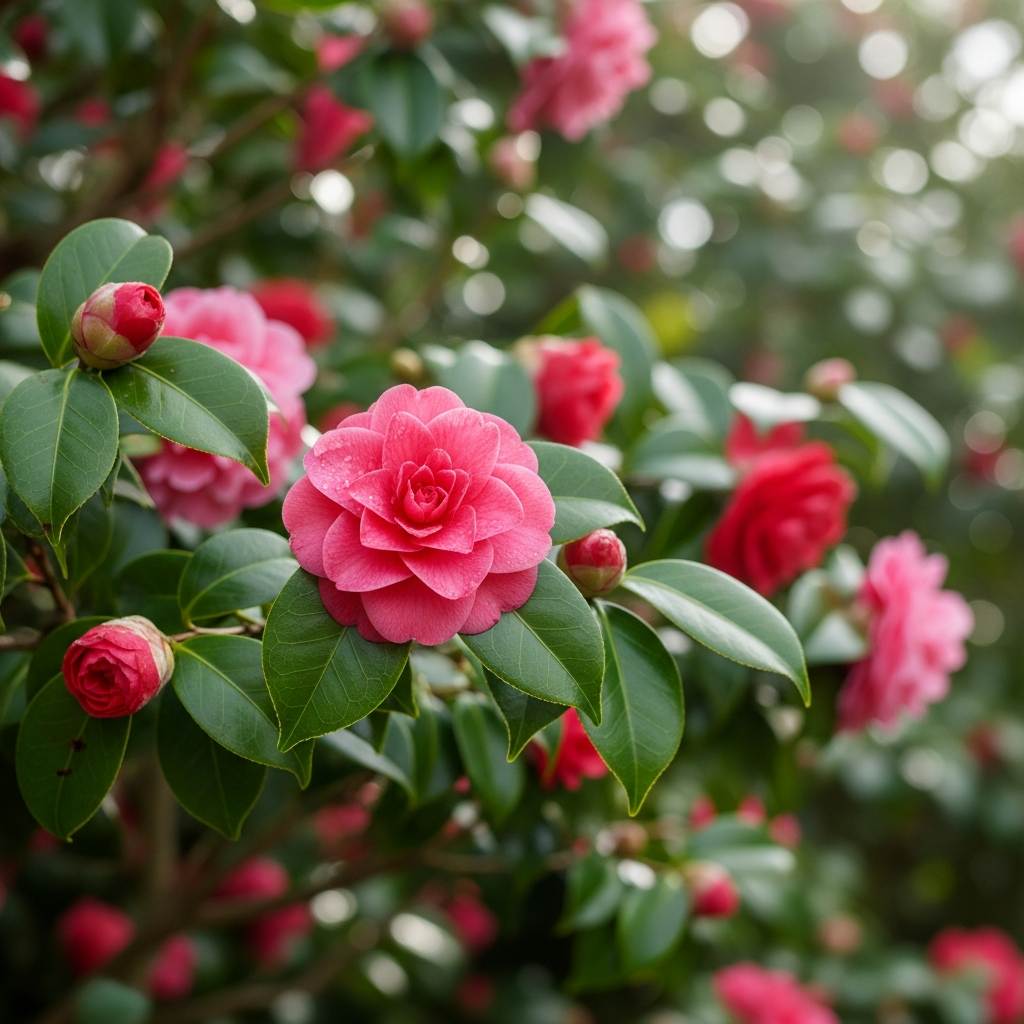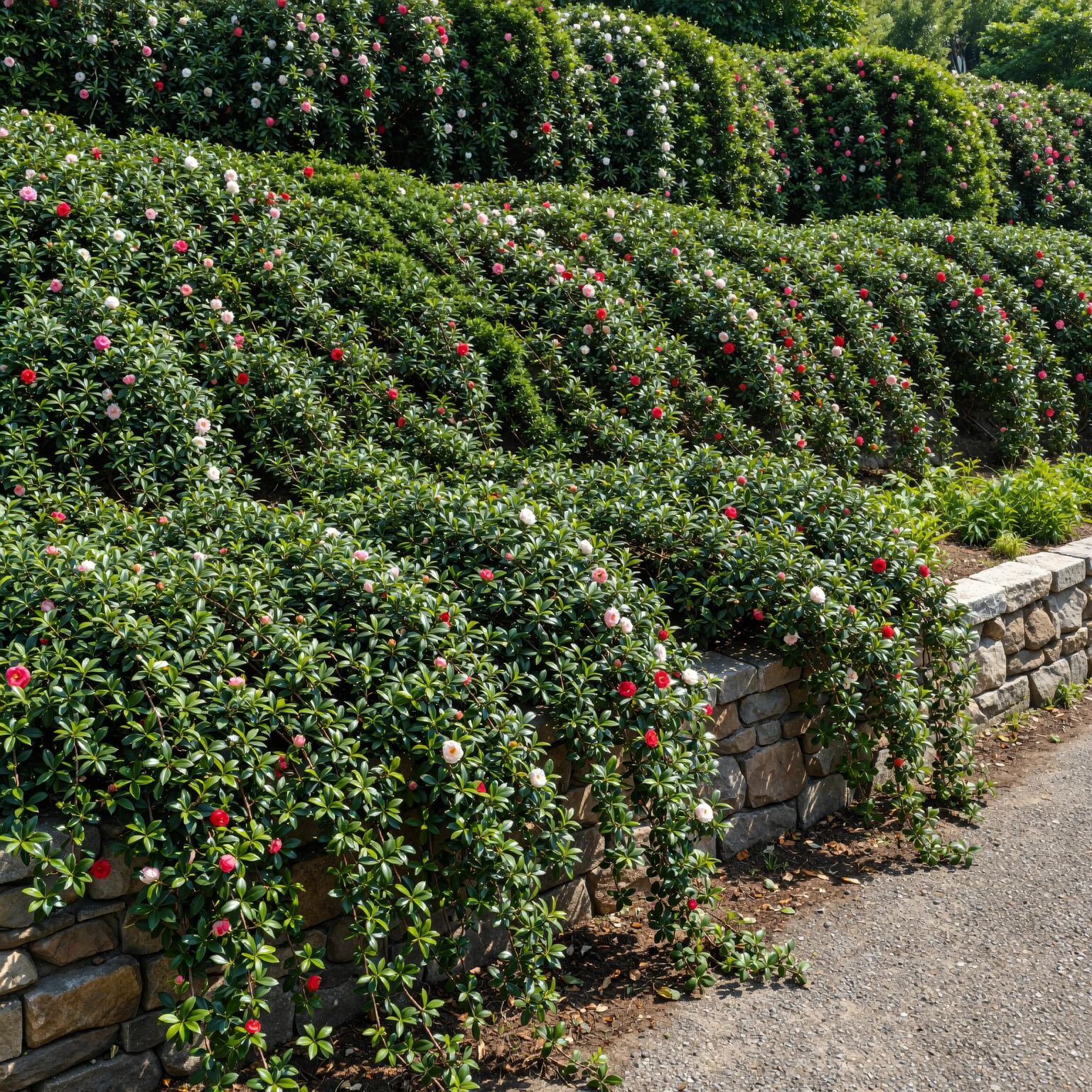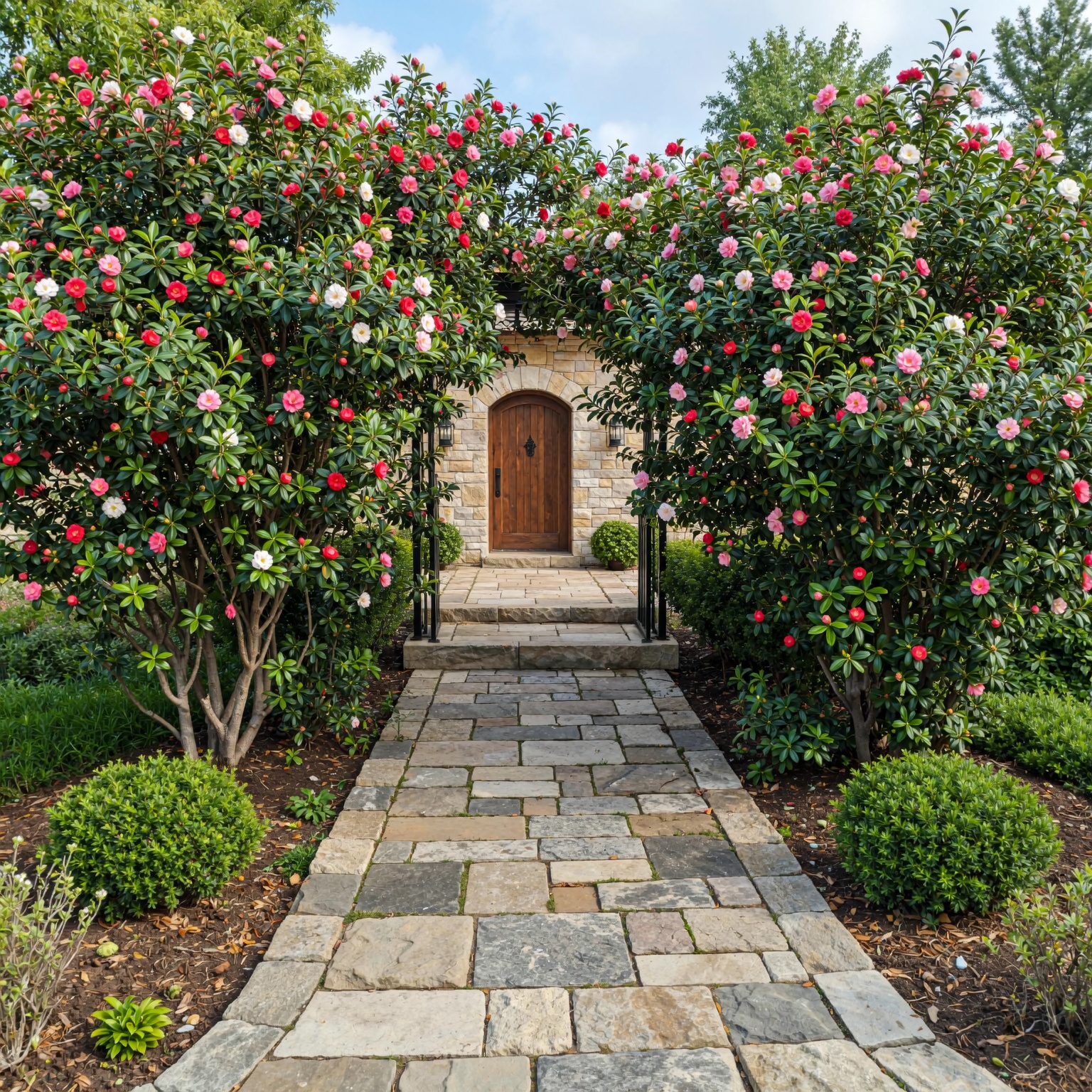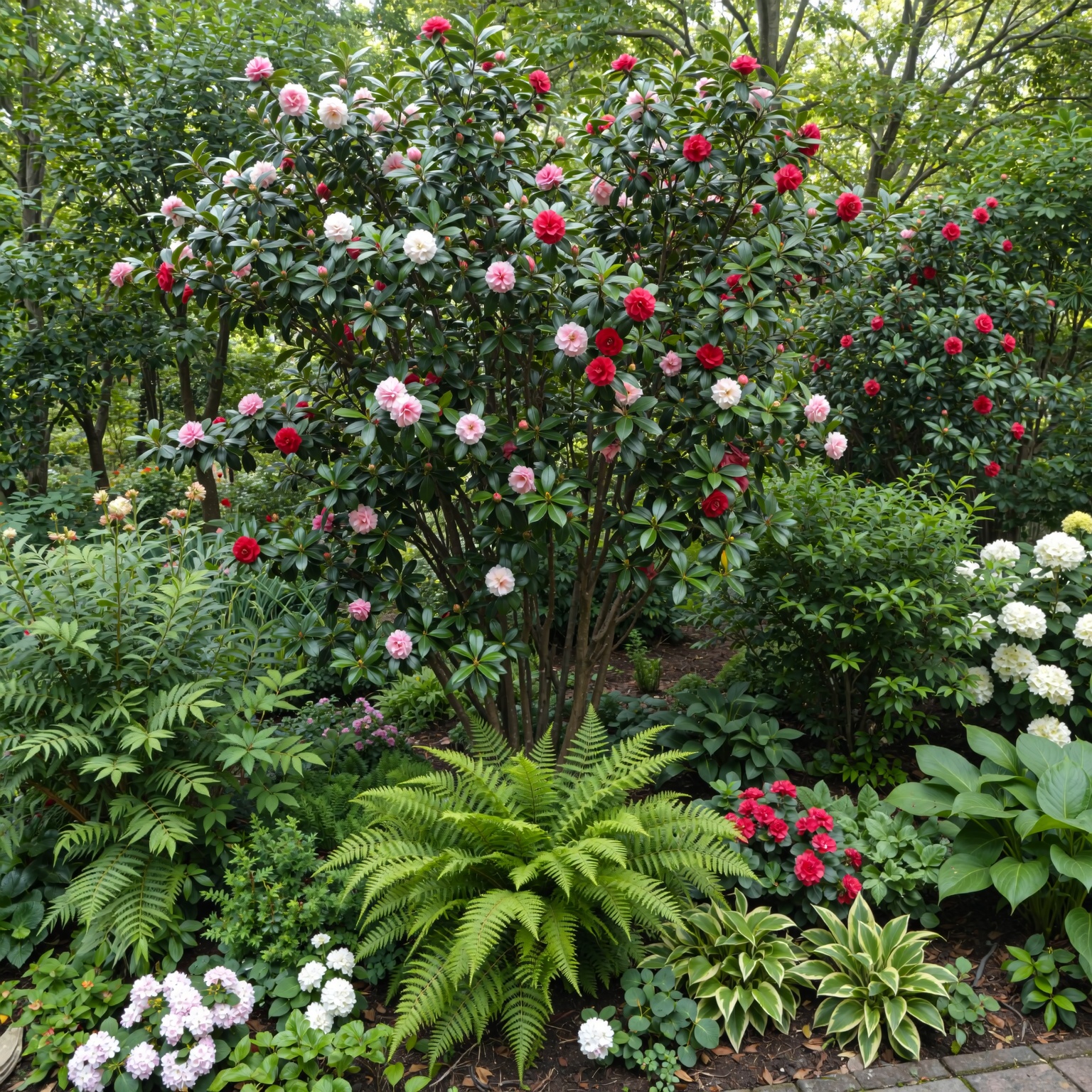Camellia landscaping offers countless possibilities for creating beautiful, functional garden spaces. With their evergreen foliage, stunning blooms, and adaptable growth habits, camellias are among the most versatile and elegant plants you can incorporate into your landscape design. Whether you’re working with a small patio or a large estate garden, camellia landscaping can transform your landscape into a year-round showcase of natural beauty. This comprehensive guide provides essential camellia landscaping tips and tricks for creating stunning garden designs.
3. Statement Trees for Winter Interest
Camellias naturally grow as shrubs, but with proper pruning, they can be trained into beautiful small trees that provide structure and winter interest. This technique elevates camellias into focal points that command attention throughout the year.
Training Methods:
- Select a camellia that’s naturally tall and wide
- After flowering, prune away lower branches gradually
- Leave multiple trunks for a more natural look, or select 3 to 5 strongest trunks
- Remove all branches from the lower third of selected trunks
- Continue this process over several years to develop tree form
Best Varieties for Tree Form:
- Large japonica varieties for substantial tree presence
- Varieties with upright growth habits
- Plants with attractive branching patterns
Design Benefits:
- Creates focal points in landscape design
- Provides winter structure when other plants are dormant
- Allows for underplanting with shade-loving perennials
- Adds vertical interest to flat garden areas

4. Stunning Specimen Plants
A single, well-placed camellia can serve as a stunning focal point in your garden. As specimen plants, camellias showcase their unique forms, beautiful blooms, and elegant foliage. This application works particularly well in smaller gardens where every plant counts, or in larger landscapes where you want to highlight specific areas.
Choosing Specimen Plants:
- Select varieties with exceptional flower forms or colors
- Consider plants with attractive growth habits
- Choose varieties that bloom at different times for extended interest
- Position where the plant can be viewed from multiple angles
Design Considerations:
- Place in locations with filtered light or partial shade
- Ensure well-draining soil and adequate space for mature size
- Consider surrounding plants that complement without competing
- Use as anchors in garden beds or as standalone focal points
Best Locations:
- Entryway gardens for welcoming first impressions
- Corner plantings to soften hardscape edges
- Center of island beds for year-round structure
- Strategic positions where blooms can be appreciated

5. Natural Groundcovers and Cascading Plantings
Low-growing sasanqua varieties with horizontal or weeping growth habits make excellent groundcovers for slopes, banks, or areas where you want cascading beauty. These varieties create a natural, flowing appearance that softens hardscape edges and adds texture to garden designs.
Perfect Applications:
- Slopes and banks where erosion control is needed
- Cascading over walls or container edges
- Naturalistic gardens where plants can spread freely
- Areas where deer might be a concern (they’ll munch flowers but leave foliage)
Best Varieties for Groundcover:
- ‘Shishi Gashira’ for low, spreading habit
- ‘White Doves’ for cascading white blooms
- ‘Marge Miller’ for full, soft pink cascading flowers
- Low-growing sasanqua varieties with horizontal growth
Design Tips:
- Allow plants to spread naturally for informal appearance
- Plant on slopes where cascading form is most effective
- Combine with other groundcovers for layered texture
- Use to soften hardscape edges and create natural transitions

6. Delightful Disguises and Problem-Solving Plantings
One of the most practical uses for camellias is hiding unsightly elements in your landscape. Whether it’s an unattractive fence, a garage wall, or a narrow space that needs softening, camellias can transform problem areas into beautiful garden features.
Common Problem Areas:
- Unsightly fences that need screening
- Garage walls or side yards that need beautification
- Narrow spaces along driveways that need interest
- HOA-installed fences that lack privacy
- Areas where you need shade-loving plants that don’t require constant attention
Design Solutions:
- Create living walls that hide infrastructure
- Add privacy while maintaining visual appeal
- Soften hardscape with evergreen foliage
- Provide year-round interest in challenging locations
Best Varieties for Screening:
- Large, upright varieties for substantial screens
- Dense-foliaged varieties for maximum coverage
- Varieties with extended bloom times for seasonal interest
Additional Landscaping Tips and Tricks
Creating Vibrant Entryways
Line walkways or entry points with camellias to establish a welcoming atmosphere. By selecting varieties with staggered bloom times, you can ensure continuous color from fall to spring. Plant them in well-draining soil with partial shade, and space them adequately to accommodate growth. The result is a lush, full border that becomes more impressive over time.
Design Elements:
- Use varieties with complementary colors for visual harmony
- Stagger heights for dynamic visual interest
- Consider fragrance for sensory appeal near entryways
- Plan for mature size to avoid overcrowding

Utilizing Camellias as Living Sculptures
Camellias’ dense foliage makes them ideal candidates for topiary art. Shape them into various forms, such as spirals or abstract designs, to serve as focal points in your garden. This approach adds year-round visual interest and can be adapted to both expansive front yards and intimate patios.
Topiary Techniques:
- Start with young, flexible plants
- Use frames for complex shapes
- Prune regularly to maintain form
- Consider formal vs. informal garden styles
Designing Tranquil Garden Corners
Transform shaded corners into serene retreats by planting camellias. Their evergreen leaves and soft blooms create a calming ambiance, perfect for quiet reflection. Complement the camellias with understated garden furniture or simple hardscape elements to complete the peaceful setting.
Pairing Camellias with Complementary Plants
Camellias serve as excellent backdrops for other flowers. Plant them near hydrangeas to camouflage the latter when they’re dormant. Additionally, low-growing sasanqua varieties with horizontal growth habits can be used as groundcovers, adding depth and texture to your garden.
Perfect Companions:
- Ferns: Complement camellias’ glossy leaves with fine-textured fronds
- Azaleas: Share similar cultural requirements and bloom times
- Hostas: Provide contrasting foliage textures
- Hydrangeas: Camellias hide dormant hydrangeas while providing structure
- Shade-loving perennials: Create layered garden designs

Incorporating Camellias into Woodland Settings
If you have a woodland garden, camellias can thrive under tall trees that offer dappled light. Their adaptability allows them to blend seamlessly into naturalistic landscapes, providing color and structure without overwhelming existing flora. Underplant camellias with shade-loving perennials and groundcovers to create a layered, naturalistic look.
Container Gardening for Versatility
For those with limited space or who prefer flexible garden designs, camellias can be grown in containers. This allows you to move them as needed to optimize light exposure and integrate them into various parts of your garden or patio.
Container Tips:
- Use appropriately sized containers with good drainage
- Choose wooden tubs or half-barrels for larger specimens
- Use potting mix rich in organic matter
- Ensure adequate drainage to prevent root rot
- Water and fertilize regularly for container-grown plants
Best Locations for Containers:
- Patios and decks where space is limited
- Entryways for welcoming displays
- Areas where you need flexibility to move plants
- Northern or eastern exposures that receive filtered light
Planning for Seasonal Interest
By selecting camellia varieties with different bloom times, you can ensure your garden remains vibrant across multiple seasons. This strategic planning keeps your landscape engaging and colorful throughout the year.
Bloom Timing Strategy:
- Early Season (October-December): Sasanqua varieties for fall color
- Mid-Season (December-February): Hybrid varieties for winter interest
- Late Season (February-April): Japonica varieties for spring color
Design Benefits:
- Continuous color from fall through spring
- Extended seasonal interest when other plants are dormant
- Ability to create garden “seasons” with strategic variety selection
- Year-round structure with evergreen foliage
Essential Planting and Care Tips for Landscape Success
Proper Planting Technique
The most common mistake people make is planting camellias too deep. The trunk base should be just above the soil line, not buried. This prevents root rot and ensures healthy growth. After planting, add several inches of mulch to keep roots cool and maintain soil moisture.
Planting Steps:
1. Dig hole twice as wide as root ball, but only as deep as container
2. Position plant so trunk base is slightly above soil line
3. Backfill with native soil, avoiding heavy amendments in planting hole
4. Apply 2-3 inches of organic mulch around base
5. Water deeply after planting
Soil and Drainage Requirements
Camellias are acid-loving plants that do best in well-drained soil amended with organic materials such as compost. Good drainage is crucial—poor drainage is often the cause of bud drop and other problems. If you have heavy clay soil, consider raised beds or container growing.
Light and Siting Considerations
Camellias can add color to northern or eastern decks or patios, or can be placed in gardens when there’s filtered light from overhanging eaves or trees. The two most commonly grown kinds of camellia are sasanquas and japonicas. Sasanquas, with their open, airy structure and smaller flowers and leaves, can handle more sun than japonicas. Sasanquas tend to bloom earlier, too. Japonicas are larger in size, with bigger leaves and flowers, and they thrive in shade. Japonicas tend to bloom later in the season.
Fertilization Schedule
Camellias need fertilizer, but not when they’re in bud or flower. Wait at least a month after they finish blooming, then apply an acid-based fertilizer every eight weeks until they set their buds. This timing ensures plants receive nutrition when they need it most, without interfering with bloom development.
Pruning for Landscape maintenance
Prune camellias after they finish flowering to maintain their shape and remove any dead or diseased wood. This practice encourages vigorous growth and abundant blooms in the following season. Avoid heavy pruning during the growing season to prevent stress on the plant.
Pruning Tips:
- Prune immediately after flowering ends
- Remove dead or damaged branches first
- Shape gradually over several years
- Avoid removing more than one-third of plant at once
- Use clean, sharp tools for healthy cuts
Choosing Your Planting Strategy: Mass, Mingle, Single Specimen, Hedge, or Dedicated Bed
One of the most important decisions in camellia landscaping is choosing how to arrange your plants. Each planting strategy offers unique benefits and creates different visual effects. Understanding when and how to use each approach will help you create the perfect landscape design for your specific needs and garden style.

Mass Plantings: Creating Dramatic Impact
Mass plantings involve grouping multiple camellias of the same variety together to create a bold, unified statement. This approach maximizes visual impact and creates a cohesive look that’s particularly effective in large landscapes or when you want to make a strong design statement.
When to Use Mass Plantings:
- Large landscapes where you need substantial visual impact
- Creating dramatic seasonal displays when plants are in bloom
- Areas where uniformity is desired for formal garden styles
- Establishing a strong color theme in your landscape
- Large properties where individual plants would get lost
Design Benefits:
- Creates maximum visual impact when in bloom
- Establishes strong color themes throughout the landscape
- Provides substantial structure and year-round interest
- Creates a unified, cohesive appearance
- Makes a bold statement in large garden spaces
Variety Selection for Mass Plantings:
- Choose varieties with similar growth habits and sizes
- Select plants with consistent bloom times for synchronized display
- Consider varieties that maintain attractive form when not in bloom
- Use varieties with complementary colors or create monochromatic displays
- Ensure all plants have similar cultural requirements
Planting Guidelines:
- Space plants closer together than normal (4-5 feet apart) for mass effect
- Plant in odd numbers (3, 5, 7, 9) for more natural appearance
- Consider mature size when spacing to avoid overcrowding
- Plan for maintenance access between plant groups
- Use varieties with similar growth rates for uniform appearance
Best Varieties for Mass Plantings:
- ‘Silver Waves’ for spectacular white blooms with yellow centers
- ‘Nuccio’s Gem’ for elegant white formal double blooms
- ‘Alabama Beauty’ for large pinkish-red blooms in fall
- ‘Just Chill Double Mauve’ or ‘Just Chill Double White’ for cold-hardy mass displays
- Varieties with extended bloom periods for longer seasonal interest
Mingled Plantings: Creating Natural Diversity
Mingled plantings combine different camellia varieties or mix camellias with other plants to create a more natural, diverse appearance. This approach works well in informal gardens, woodland settings, or when you want to extend seasonal interest through variety selection.
When to Use Mingled Plantings:
- Informal or naturalistic garden styles
- Creating extended seasonal interest with different bloom times
- Mixing with other plants for diverse garden compositions
- Woodland or cottage garden styles
- Areas where you want a more relaxed, natural appearance
Design Benefits:
- Creates extended bloom season through variety selection
- Provides natural, informal garden aesthetic
- Allows for mixing with other plants for diversity
- Offers flexibility in design and plant selection
- Creates layered, textured garden compositions
Mingling Strategies:
- Mix different camellia varieties: Combine early, mid, and late-season bloomers for continuous color
- Mix with other shrubs: Pair camellias with azaleas, rhododendrons, or hydrangeas
- Mix with perennials: Underplant with ferns, hostas, or shade-loving perennials
- Create color themes: Mix varieties with complementary or contrasting colors
- Vary sizes and forms: Combine upright, spreading, and weeping varieties for texture
Variety Selection for Mingled Plantings:
- Choose varieties with different bloom times for extended interest
- Select plants with varying sizes and forms for visual diversity
- Consider color combinations that work well together
- Mix sasanquas and japonicas for different bloom seasons
- Include varieties with different growth habits for layered effect
Planting Guidelines:
- Space plants according to their mature sizes
- Allow for natural growth and spreading
- Create visual flow between different varieties
- Consider bloom timing when positioning plants
- Plan for maintenance access throughout the planting
Best Combinations for Mingled Plantings:
- Early fall sasanquas with late winter japonicas for extended season
- White varieties with pink or red for color contrast
- Upright varieties with spreading forms for texture
- Large-flowered varieties with smaller-flowered types for interest
- Fragrant varieties mixed with non-fragrant for sensory appeal
Single Specimen: Creating Focal Points
Single specimen plantings use one carefully chosen camellia as a focal point in the landscape. This approach emphasizes the individual plant’s beauty and creates a strong visual anchor in garden designs. Perfect for smaller gardens or when you want to highlight a specific area.
When to Use Single Specimens:
- Small gardens where space is limited
- Creating focal points in landscape design
- Highlighting exceptional varieties with unique characteristics
- Entryways or key locations where plants should stand alone
- Formal garden designs where individual plants are emphasized
Design Benefits:
- Creates strong focal points in garden design
- Allows individual plant beauty to shine
- Works well in smaller spaces
- Emphasizes unique varieties or exceptional specimens
- Provides structure without overwhelming small gardens
Selecting the Perfect Specimen:
- Choose varieties with exceptional flower forms or colors
- Select plants with attractive, well-balanced growth habits
- Consider varieties with extended bloom periods
- Look for unique characteristics that make the plant stand out
- Ensure the plant has year-round appeal beyond just blooms
Positioning Specimen Plants:
- Place where plant can be viewed from multiple angles
- Position in locations with appropriate light conditions
- Ensure adequate space for mature size
- Consider background and surrounding elements
- Create visual balance with other garden features
Best Varieties for Single Specimens:
- ‘Nuccio’s Bella Rosa’ for large, spectacular deep red blooms
- ‘Nuccio’s Pearl’ for elegant blush pink formal double blooms
- ‘Silver Waves’ for huge white blooms with yellow centers
- ‘Early Wonder’ for unique lavender-pink coloration
- ‘Christmas Carol’ for festive red and white bicolor blooms
- Varieties with exceptional form, size, or color characteristics
Design Considerations:
- Surround with complementary plants that don’t compete
- Use as anchors in garden beds or island plantings
- Position strategically for maximum visual impact
- Consider seasonal interest beyond bloom period
- Plan for maintenance and access around the plant

Hedges: Creating Living Walls
Hedge plantings use camellias in a row to create living walls that provide privacy, structure, and year-round beauty. This formal approach creates boundaries, screens unsightly views, and adds permanent structure to the landscape.
When to Use Hedges:
- Creating privacy screens or property boundaries
- Defining garden spaces or creating garden rooms
- Screening unsightly views or infrastructure
- Establishing formal garden structure
- Creating windbreaks or noise barriers
Design Benefits:
- Provides year-round privacy and screening
- Creates permanent structure in landscape design
- Establishes boundaries and defines spaces
- Offers evergreen beauty throughout the year
- Creates formal, structured garden appearance
Hedge Design Considerations:
- Spacing: Plant 5-6 feet apart for hedge plantings (closer for faster fill-in)
- Variety Selection: Choose varieties with similar growth rates and sizes
- Uniformity: Select same variety for uniform appearance, or mix carefully
- Height Planning: Consider mature height when choosing varieties
- Maintenance: Plan for regular pruning to maintain hedge shape
Best Varieties for Hedges:
- Tall Hedges (8-15 feet): ‘Alabama Beauty’, ‘Pink-A-Boo’, ‘Yuletide’
- Medium Hedges (6-8 feet): ‘Nuccio’s Bella Rosa’, ‘Nuccio’s Gem’, ‘Early Wonder’
- Low Hedges (3-5 feet): ‘October Magic Orchid’, ‘October Magic White ShiShi’, compact sasanquas
- Fast-Growing: Sasanqua varieties for quicker results
- Formal Appearance: Japonica varieties for more structured, formal hedges
Hedge Maintenance:
- Prune after flowering to maintain shape
- Trim regularly during growing season for formal hedges
- Allow natural growth for informal hedges
- Remove dead or damaged branches promptly
- Maintain consistent height and width along hedge length
Planting Tips for Hedges:
- Prepare entire planting area, not just individual holes
- Ensure consistent soil conditions along hedge length
- Plant in straight lines using string or stakes for guidance
- Water consistently along entire hedge during establishment
- Apply mulch uniformly along hedge base
Dedicated Beds: Creating Camellia Gardens
Dedicated beds are garden areas designed specifically for camellias, either as a single-variety collection or a curated selection of varieties. This approach creates specialized garden spaces that showcase camellias as the primary focus, often with companion plants that complement their beauty.
When to Use Dedicated Beds:
- Creating specialized camellia collections
- Designing gardens focused on camellia appreciation
- Areas with ideal camellia growing conditions
- Formal garden designs featuring camellias
- Creating seasonal displays focused on camellia blooms
Design Benefits:
- Allows for optimal growing conditions for camellias
- Creates specialized garden spaces for camellia appreciation
- Provides opportunity to showcase camellia variety and diversity
- Enables focused care and maintenance
- Creates dedicated spaces for seasonal camellia displays
Types of Dedicated Beds:
- Single-Variety Beds: Feature one variety for uniform display
- Collection Beds: Showcase multiple varieties in organized groupings
- Seasonal Beds: Designed around bloom timing for continuous color
- Color-Themed Beds: Organized by color for visual impact
- Formal Beds: Structured arrangements in formal garden style
Designing Dedicated Beds:
- Plan for mature plant sizes when designing layout
- Consider bloom timing for extended seasonal interest
- Create visual flow between different plant groupings
- Allow for maintenance access throughout the bed
- Plan for companion plants that complement camellias
Companion Plants for Dedicated Beds:
- Shade-loving perennials: Ferns, hostas, astilbes for ground layer
- Spring bulbs: Daffodils, crocuses for early season interest
- Evergreen groundcovers: Pachysandra, ivy for year-round coverage
- Shade-loving shrubs: Azaleas, rhododendrons for layered effect
- Understory trees: Japanese maples for height and structure
Best Varieties for Dedicated Beds:
- Mix early, mid, and late-season bloomers for extended display
- Combine different flower forms for visual interest
- Include varieties with different sizes and growth habits
- Select plants with complementary or contrasting colors
- Choose varieties suitable for your specific climate and conditions
Bed Maintenance:
- Maintain consistent soil conditions throughout bed
- Apply mulch uniformly to retain moisture and suppress weeds
- Monitor for pests and diseases regularly
- Prune plants according to their individual needs
- Refresh companion plants as needed
Choosing the Right Strategy for Your Garden
Selecting the best planting strategy depends on several factors:
Garden Size:
- Small gardens: Single specimens or small dedicated beds work best
- Medium gardens: Mix of strategies – hedges, specimens, and small mass plantings
- Large gardens: All strategies work well – use mass plantings for impact, hedges for structure
Garden Style:
- Formal: Hedges and dedicated beds create structured appearance
- Informal: Mingled plantings and natural specimens work better
- Cottage: Mingled plantings with companion plants
- Modern: Single specimens or mass plantings for clean lines
Functional Needs:
- Privacy: Hedges provide best screening
- Focal points: Single specimens create strong visual anchors
- Seasonal display: Mass plantings or dedicated beds maximize bloom impact
- Natural appearance: Mingled plantings create relaxed aesthetic
Maintenance Considerations:
- Low maintenance: Single specimens or small dedicated beds
- Moderate maintenance: Hedges and mingled plantings
- Higher maintenance: Large mass plantings and extensive dedicated beds
Budget and Time:
- Immediate impact: Mass plantings create instant drama
- Long-term investment: Hedges and dedicated beds develop over time
- Flexibility: Single specimens allow for future changes
- Collection building: Dedicated beds allow gradual expansion
Final Thoughts on Camellia Landscaping
Camellias offer unparalleled versatility in landscape design, providing year-round structure, seasonal blooms, and countless design possibilities. Whether you’re creating privacy screens, training espaliers, developing specimen plants, or using them as groundcovers, camellias can fulfill multiple roles in your garden.
The key to successful camellia landscaping lies in selecting the right varieties for your specific needs and understanding their cultural requirements. With proper planting, care, and strategic placement, camellias will reward you with decades of beauty and garden interest.
Remember that camellias are long-term investments in your landscape. While they may not be the fastest growers, their beauty increases with age, making them perfect for creating gardens that become more impressive over time. Plan carefully, plant correctly, and enjoy the year-round beauty these remarkable plants bring to your landscape.
